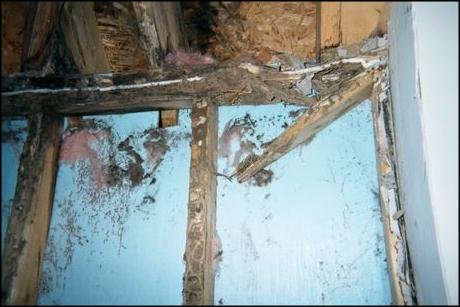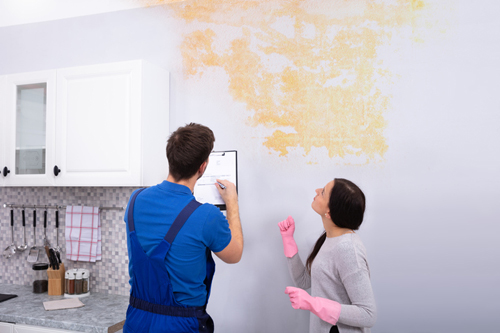Just about everyone maintains their own unique notions in relation to Water Stains on Walls.

Water stains on walls are not pleasurable to the eyes. Your residence should be without stains on the wall surfaces, roofing system, or floors. That is the suitable state of a residence and also its frameworks. In some cases it seems nearly unavoidable to experience water stains on wall surfaces in houses.
Homeowners staying in damp areas continuously deal with the anxiety of water stains on wall surfaces. That doesn't have to be the instance for you. With accurate as well as well-shaped information on the sources of water spots and also timely repair work procedures, you will constantly be a step ahead of such incidents. This article assures to be a valuable overview for you.
3 Common Reasons For Water Spots on Wall Surfaces
Unlike common belief, water stains on walls do not always come from inadequate structure products. There are several causes of water spots on walls. These include:
Poor Drain
This will stop water from leaking into the walls. This links to too much moisture that you see on the wall surfaces of your building.
The leading cause of wet walls, in this instance, can be a bad drain system. It can also result from bad administration of sewage pipelines that go through the structure.
Moist
When hot damp air consults with dry chilly air, it causes water droplets to form on the wall surfaces of structures. This happens in washrooms and also kitchen areas when there is steam from food preparation or showers. The water droplets can stain the surrounding walls in these parts of your residence as well as spread to other locations.
Damp or condensation influences the roofing as well as wall surfaces of structures. When the wall is wet, it produces an appropriate atmosphere for the growth of microbes and also fungi.
Pipe Leaks
Many homes have a network of water pipes within the wall surfaces. It constantly increases the practicality of such pipes, as there is little oxygen within the wall surfaces.
A drawback to this is that water leakage affects the walls of the building and also triggers prevalent damage. A dead giveaway of damaged pipes is the look of a water tarnish on the wall surface.
Water Spots on Wall: Repair Work Tips
When dealing with water discolorations, home owners would generally want a quick fix. Yet, they would soon recognize this is disadvantageous as the water stains repeat. So, here are a few practical pointers that will certainly assist you in the repair work of water spots on wall surfaces:
Pro Idea
A houseplant in your house also raises its humidity. So, if your home is currently humid, you may want to introduce houseplants with marginal transpiration. An instance of ideal houseplants is succulents.
Final thought
Although no person wants to have water stains on walls in their residence, it can happen to the very best people. This post provides you leverage, as you currently recognize how to handle this incident if it does happen.
It is constantly best to recruit specialist services to help fix the problems in your home.
Occasionally it seems virtually inescapable to experience water stains on wall surfaces in residences.
Contrary to preferred idea, water stains on walls do not always stem from inadequate building products. There are several causes of water spots on wall surfaces. The water beads can discolor the bordering wall surfaces in these parts of your residence and also spread to various other areas.
Here are a few helpful ideas that will certainly assist you in the repair of water spots on walls:
CHECKING FOR WATER DAMAGE
Water damage can be costly, and it may begin before you even notice the first signs of trouble. Water damage can cause mold and mildew in your walls and floors, which can create an abundance of health concerns for your family. It can also lead to costly repairs of various appliances and general home fixtures. To avoid the pricey consequences of water damage, here are Warner Service’s top 5 places you should check:
The walls – The easiest place to spot the beginnings of water damage is on the walls and ceilings of your home. If water damage is present, there will most likely be water stains, especially around the windows and doorframes, and/or cracks in the drywall. If a stain looks unusual (discolored to brown, black or gray, raised texture), has a swollen appearance or is soft to the touch, contact a professional immediately. The pipes – To avoid water damage, consistently check the pipes in your kitchen (especially the dishwasher and ice maker), bathrooms, laundry room (specifically washing machines) and basement for corrosion, leaks and water stains. Pay special attention to where the pipes connect in your home and the location of caulking around the bathroom fixtures, including toilets, sinks, showers and tubs. Missing or loose caulking and grout could be signs of leaking water. This seepage can also quickly cause mold and rust, so double check your water heater and tank for wet spots on the floor. The floor – Water damage is very easy to spot on the floor. Look for any warping or buckling of the material, especially in the basement. If your home has wood flooring, look for bright white or dark stains. If your home has carpeting, keep it dry and clean. A damp carpet that smells of mold could cause water damage and health problems. To avoid this, consider installing floor pans under your appliances to help prevent damages from small, slow and undetected leaks. The basement and attic – If your basement or attic smells odd check for mold and mildew around the area, especially the valley where the roof meets. While you are inspecting those areas, check for wall cracks, floor stains, rust and dampness in the insulation. If you live in a colder and/or rainier climate, perform routine checks for water damage from melting snow or ice and rain. The exterior – Check the roof for damaged flashing and missing, cracked or curled shingles. There should also be no standing water anywhere outside your home. This could be caused by puddles, leaky rain gutters or hoses, poor drainage, or short gutter spouts. Invest in a sump pump system or water flow monitoring system, and perform routine maintenance on these outdoor appliances to avoid indoor water damage.

I came across that page about when looking around the web. For those who enjoyed reading our blog post if you please be sure to pass it around. Thanks so much for going through it.
Call Us Now